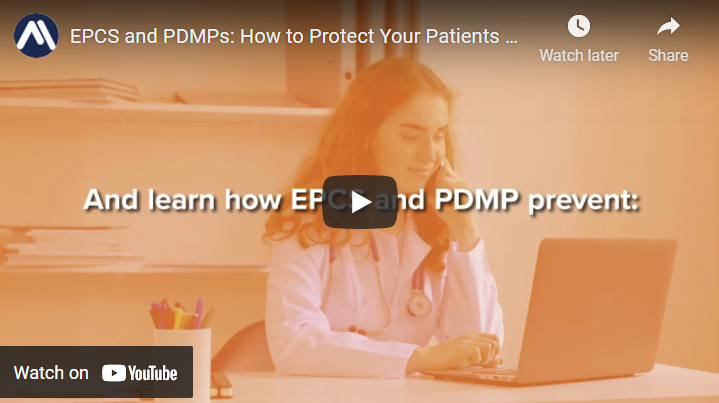What's the Difference Between EPCS and PDMP?
Posted by Janna Vienca Cañezal
Regulations EHR Prescription Management
Over the years, EPCS and PDMPs helped fight the battle against the opioid epidemic. State mandates drove the adoption of EPCS and PDMP, with several mandates taking effect in 2021. If you missed your state’s deadline, it’s not too late to implement both tools into your workflow today. Compliance with federal regulations and state mandates can be confusing, but knowing the difference between EPCS and PDMP is a good starting point in staying compliant. Here’s a quick guide on how to get started.
What is EPCS?
Electronic Prescribing of Controlled Substances, or EPCS, is a secure way of transmitting electronic prescriptions of controlled substances to a pharmacy. It incorporates an OTP (one-time password) system by using hard or soft tokens into the e-prescribing workflow for additional security. EPCS reduces the chances of doctor-shopping and prescription fraud. It also eliminates the use of paper prescriptions, which can be altered, lost, or stolen.
As required by the U.S. Drug Enforcement Agency (DEA), providers need to undergo a complete identity proofing process before they can e-prescribe controlled substances.
Read More: What Is EPCS & Does My Practice Need It?
What is a PDMP?
Prescription Drug Monitoring Program (PDMP) is an electronic database of a patient’s history of dispensed controlled substances from different providers. When pharmacists dispense controlled substances to patients, they enter the information in their state-based PDMP. Providers then use that information to make informed prescribing decisions, check possible medication misuse, and detect instances of “doctor shopping.”
PDMPs are used as public health tools too. State health departments use PDMP to determine opioid epidemic trends and implement necessary interventions. PDMPs can also help check inappropriate prescribing behavior and potential drug abuse patterns and inform the necessary authorities.
What’s the Difference Between EPCS and PDMP?
.png?width=730&name=NEW!%20Meditab%20Blog%20Images%20(33).png)
EPCS is the tool you use for sending controlled substances to pharmacies, while PDMP is the database for looking up a patient’s prescription history of controlled substances. EPCS and PDMPs complement each other and should be used hand in hand. Before prescribing controlled substances, providers are encouraged to check their state’s PDMP first. In recent years, several states now require providers to include PDMP in their e-prescribing workflow.
EPCS vs. PDMP: Which One is More Important?
EPCS and PDMP are equally important. When available at the point of service, they provide critical information about the patient’s prescription history and help prevent medication abuse. Both tools help providers determine who legitimately needs medications and those who intend to misuse scheduled drugs.
When deciding which tool to prioritize, consider several factors affecting your practice’s compliance. Is there an upcoming EPCS mandate in your state, or has it passed already? If yes, you might want to prioritize EPCS over PDMP. Do you prescribe drugs under Medicare Part D? Then prioritize EPCS to comply with the SUPPORT for Patients and Communities Act of 2018.
Additionally, some states require checking PDMP data before prescribing for all scheduled drugs. On the other hand, some states require using PDMP under certain circumstances only. If you are unsure about your requirements, you can check directly with your state’s health department or pharmacy board.
On the bright side, EHRs can help you reduce the burden of implementing both tools into your workflow without sacrificing the other.
How Meditab Can Help You Stay Compliant
.png?width=730&name=NEW!%20Meditab%20Blog%20Images%20(32).png)
Practices that integrate their EHR with EPCS and PDMP save time, improve patient safety, and achieve efficiency. There’s no need to leave your EHR system when e-prescribing controlled substances and checking PDMP data if you have the right software.
IMS, Meditab’s core EHR, offers complete EPCS and PDMP support. You won’t have to worry about prioritizing one over the other since the implementation team seamlessly guides you through each step. Meditab’s recent webinar, “EPCS and PDMPs: How to Protect Your Patients and Stay Compliant,” demonstrates our complete e-prescribing workflow. Features such as one-click access to your state’s PDMP, hard and soft token authentication, and analytical reports make sure you stay within regulations.
Watch the Full Webinar:
Share this post: on Twitter on Facebook on Google+

.png)
